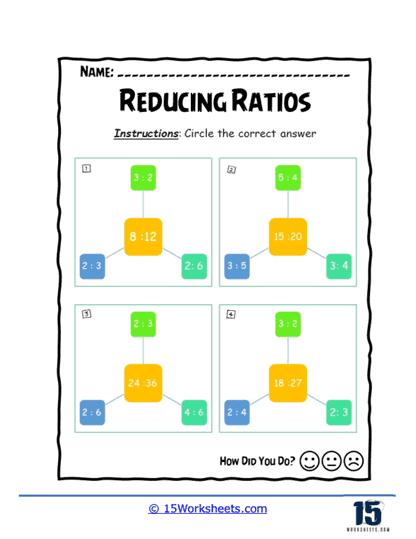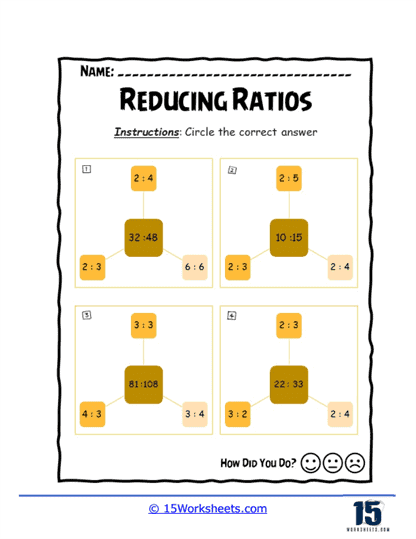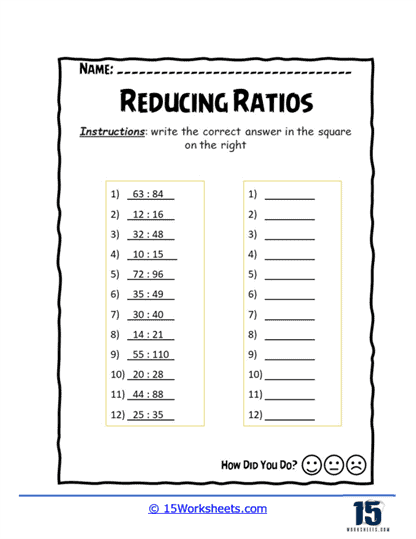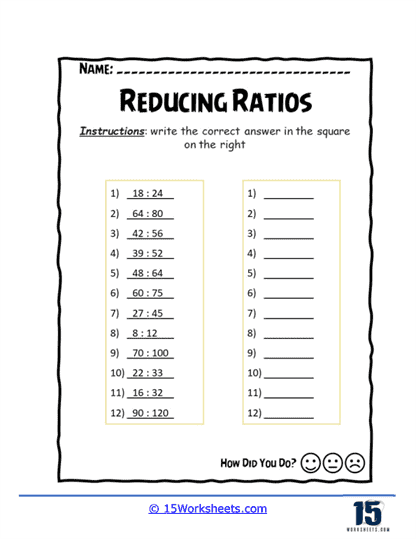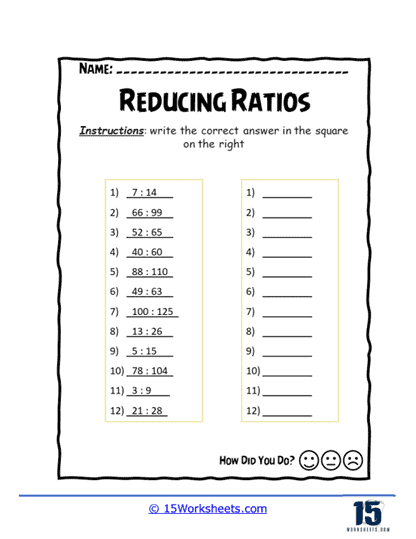Reducing Ratios Worksheets
All About These 15 Worksheets
Reducing ratios worksheets will help students understand how to simplify ratios to their lowest terms. Ratios represent the relationship between two or more quantities, and reducing them involves dividing both terms of the ratio by their greatest common divisor (GCD) so that the ratio expresses the simplest possible form of the relationship. These worksheets often serve as practice for students learning about ratios in mathematics, typically in upper elementary or middle school. They are an essential part of building foundational skills in proportion, scaling, and comparative reasoning.
Structure of Collection
Reducing ratios worksheets are carefully structured to guide students through the process of simplifying ratios step by step. These worksheets vary in complexity, but they all aim to develop a student’s ability to manipulate and understand the underlying mathematics of ratios. Here’s a breakdown of the types of things commonly seen on these worksheets:
Basic Ratio Pairs – A fundamental aspect of these worksheets is presenting students with pairs of numbers that represent ratios. These pairs might appear as whole numbers, such as 8:12 or 15:20, and the student’s task is to reduce the ratio to its simplest form. For example, 8:12 would simplify to 2:3 by dividing both numbers by 4, the GCD of 8 and 12.
Word Problems Involving Ratios – Another type of problem commonly seen on reducing ratios worksheets involves word problems where students must extract ratios from a real-world scenario. For example, the worksheet might describe a situation where there are 12 red apples and 16 green apples in a basket, asking the student to express this ratio in its simplest form. This encourages students to apply their understanding of ratios to everyday contexts, emphasizing how ratios are relevant outside of purely mathematical exercises.
Equivalent Ratios – Equivalent ratio problems often accompany reducing exercises. In this case, students are given a ratio and asked to find multiple equivalent ratios or asked to verify if two given ratios are equivalent after simplifying them. For instance, if a worksheet presents the ratio 6:9, students might be asked to simplify it to 2:3, and then verify whether other pairs, such as 4:6 or 8:12, are equivalent to this simplified ratio.
Multiple Terms in Ratios – Some worksheets will challenge students further by presenting ratios with more than two terms. For example, students might be asked to simplify a three-term ratio such as 10:20:30, simplifying it to 1:2:3. These problems require students to extend their knowledge of simplifying two-term ratios and apply it to more complex relationships. This not only enhances their mathematical skills but also encourages attention to detail.
Use of Fractions and Decimals in Ratios – Some worksheets include ratios that involve fractions or decimals, pushing students to deal with non-whole numbers. For instance, a worksheet might present a ratio of 0.5:2.5, which the student would need to simplify to 1:5. Similarly, fractions such as 3/4:6/8 can also appear, and students must apply both their fraction and ratio knowledge to reduce the ratio correctly. These kinds of problems deepen students’ comprehension and flexibility when working with different number forms.
Visual Aids and Graphical Representations – Reducing ratios worksheets often incorporate visual aids such as grids, pie charts, or bar graphs to represent ratios graphically. For example, a pie chart might show a division of sections that represent the ratio of parts, and students are required to reduce these parts to their simplest form. Visual representations help students connect abstract ratio concepts with tangible visuals, improving their overall understanding of how ratios operate in the world around them.
Many reducing ratios worksheets also include step-by-step examples to show students how to find the GCD and apply it to simplify the ratio. These examples guide students through the logical process of determining the GCD and dividing both terms, ensuring they understand how to approach similar problems independently.
Answer keys with detailed explanations are frequently included, allowing students to check their work and understand their mistakes. When students encounter errors, they can refer to the step-by-step process laid out in the explanations, reinforcing their understanding of how ratios are simplified. These keys often provide extra guidance for students who may be struggling with the concept, allowing them to learn from their errors.
The Value of These Worksheets
Reducing ratios worksheets serve as essential tools in reinforcing key mathematical concepts and developing skills that students will use both in academic settings and in the real world. Here’s how working with these worksheets can benefit students:
Strengthening Problem-Solving Skills
Simplifying ratios is a fundamental skill that prepares students for more advanced mathematical topics, such as proportions, algebra, and geometry. Practicing with these worksheets enables students to build fluency in basic arithmetic operations, such as finding the GCD, division, and multiplication. This practice strengthens their number sense and gives them the tools needed to tackle more complex mathematical problems in the future.
Working through the various types of problems on reducing ratios worksheets encourages students to develop their problem-solving abilities. Whether they are simplifying basic ratios, extracting ratios from word problems, or dealing with complex ratios involving fractions or decimals, students must use logical reasoning and step-by-step approaches to reach the correct answer. Over time, this practice helps students become more adept at breaking down complex problems into manageable parts, a crucial skill in mathematics and beyond.
Real-World Application of Ratios
Ratios appear frequently in everyday life, from cooking recipes to financial analysis, construction projects, and scientific measurements. By practicing with reducing ratios worksheets, students become comfortable with ratios and learn how to apply them in practical situations. For instance, when following a recipe that calls for ingredients in specific ratios or comparing quantities of ingredients, the ability to simplify and understand ratios allows individuals to adjust proportions easily and accurately.
Reducing ratios requires students to think analytically, especially when determining the GCD and applying it to simplify the ratio. This analytical thinking translates to other areas of study and work, as students learn to identify patterns, make connections, and approach problems methodically. These skills are valuable not only in mathematics but also in science, engineering, economics, and any field that requires careful reasoning and critical thinking.
Students who regularly practice reducing ratios tend to develop greater confidence in their ability to handle numbers. As they become more proficient at simplifying ratios and recognizing equivalent ratios, they build a solid foundation in number manipulation. This increased confidence is important for students’ overall mathematical development, as it encourages them to tackle more challenging problems with less hesitation.
Practicing with reducing ratios worksheets enables students to approach a variety of real-world problems with flexibility and adaptability. Whether comparing distances on a map, determining proportions in a design project, or analyzing statistical data, students who are skilled in working with ratios can adapt to many different situations. This versatility is a valuable skill in many careers, particularly those that involve data analysis, engineering, architecture, and project management.
By offering various types of problems, including basic ratio pairs, word problems, and problems involving fractions or decimals, these worksheets provide students with a comprehensive and engaging way to practice reducing ratios. The skills gained from working with these worksheets-such as mathematical fluency, problem-solving abilities, real-world application, and analytical thinking-are not only important for academic success but also for navigating everyday challenges in fields like finance, business, and science. The regular practice of simplifying ratios builds a strong foundation for future learning and equips students with essential skills they will use throughout their lives.


